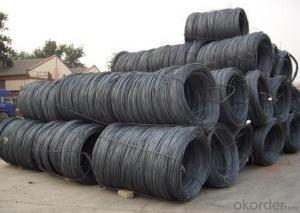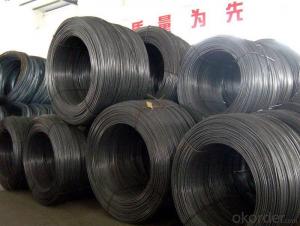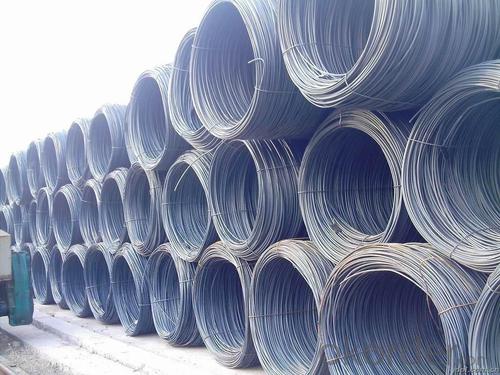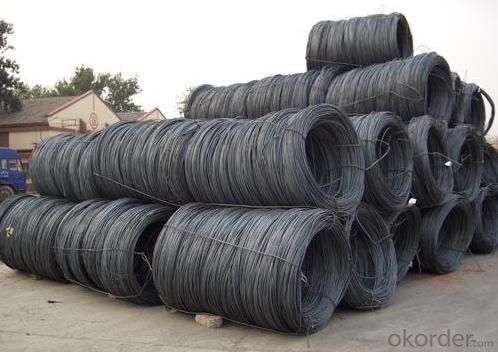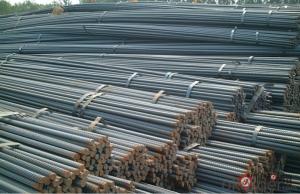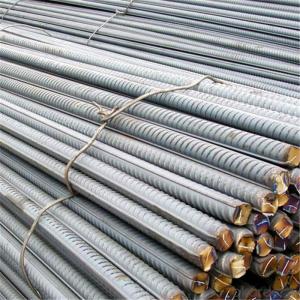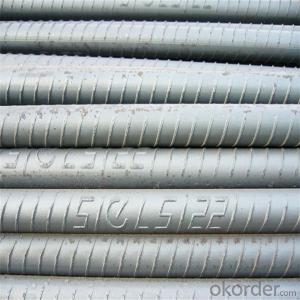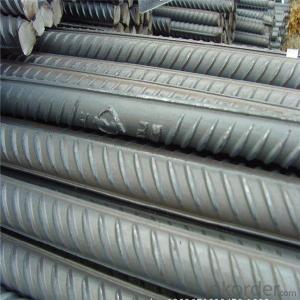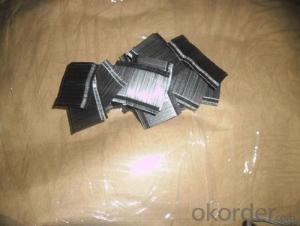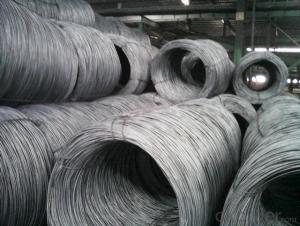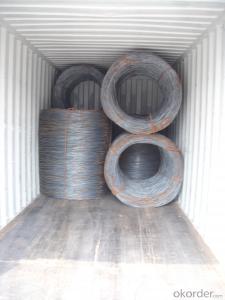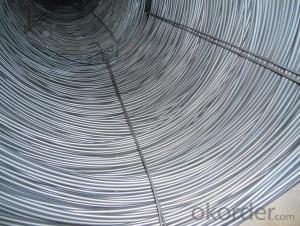Wire Rods Steel for Construction/ Concrete Usage
- Loading Port:
- Tianjin
- Payment Terms:
- TT or LC
- Min Order Qty:
- 28 m.t.
- Supply Capability:
- 40000 m.t./month
OKorder Service Pledge
OKorder Financial Service
You Might Also Like
Product Description:
OKorder is offering Wire Rods Steel for Construction/ Concrete Usage at great prices with worldwide shipping. Our supplier is a world-class manufacturer of steel, with our products utilized the world over. OKorder annually supplies products to European, North American and Asian markets. We provide quotations within 24 hours of receiving an inquiry and guarantee competitive prices.
Product Applications:
Wire Rods Steel for Construction/ Concrete Usage are ideal for structural applications and are widely used in the construction of buildings and bridges, and the manufacturing, petrochemical, and transportation industries.
Product Advantages:
OKorder's Wire Rods Steel for Construction/ Concrete Usage are durable, strong, and resist corrosion.
Main Product Features:
· Premium quality
· Prompt delivery & seaworthy packing (30 days after receiving deposit)
· Corrosion resistance
· Can be recycled and reused
· Mill test certification
· Professional Service
· Competitive pricing
Product Specifications:
wire rod:
Grade:SAE1006B/SAE1008B/SAE1018B
Size:5.5/6.5/7/8/9/10/11/12mm
wire rods are suitable for a wide range of applications such as : -
fasteners, bolts, rivets, screws,
general purpose wires,
electrode wires, industrial wires, agriculture wires,
bush wires, chain rivet wires,
detonator wire,
Umbrella ribs, upholstery wires, cycle spokes, needle wires, heald wires, staple pin Wire, safety pin wires
ACSR wires, earth wires,
tyre and hose reinforcement wires,
prestressed concrete wire, springs and rope wires,
card clothing wires,
vineyard wires,
ball bearing quality
Automobile parts like screw, fasteners, bush, spline, socket, connecting rod, shaft, gear, rivets, engine shaft, connecting rod, spindles, gears, etc.
FAQ:
Q1: Why buy Materials & Equipment from OKorder.com?
A1: All products offered byOKorder.com are carefully selected from China's most reliable manufacturing enterprises. Through its ISO certifications, OKorder.com adheres to the highest standards and a commitment to supply chain safety and customer satisfaction.
Q2: How do we guarantee the quality of our products?
A2: We have established an advanced quality management system which conducts strict quality tests at every step, from raw materials to the final product. At the same time, we provide extensive follow-up service assurances as required.
Q3: How soon can we receive the product after purchase?
A3: Within three days of placing an order, we will begin production. The specific shipping date is dependent upon international and government factors, but is typically 7 to 10 workdays.
Q4: What makes stainless steel stainless?
A4: Stainless steel must contain at least 10.5 % chromium. It is this element that reacts with the oxygen in the air to form a complex chrome-oxide surface layer that is invisible but strong enough to prevent further oxygen from "staining" (rusting) the surface. Higher levels of chromium and the addition of other alloying elements such as nickel and molybdenum enhance this surface layer and improve the corrosion resistance of the stainless material.
Q5: Can stainless steel rust?
A5: Stainless does not "rust" as you think of regular steel rusting with a red oxide on the surface that flakes off. If you see red rust it is probably due to some iron particles that have contaminated the surface of the stainless steel and it is these iron particles that are rusting. Look at the source of the rusting and see if you can remove it from the surface.

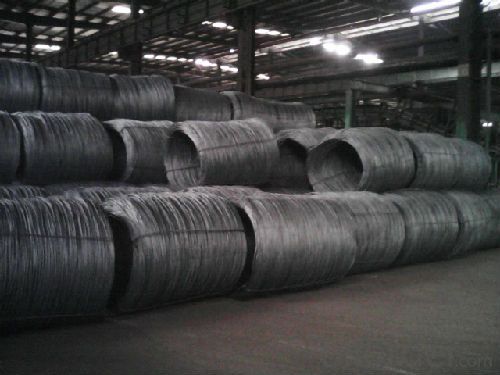
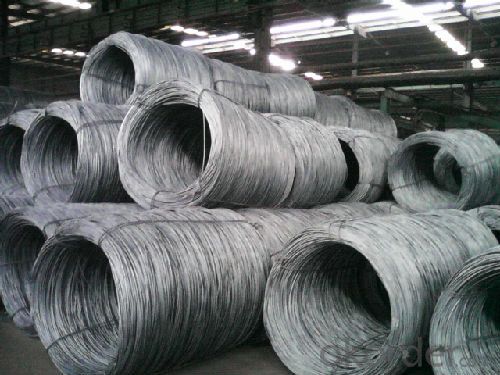
- Q: How is the bending properties of steel wire rod tested?
- Steel wire rod's bending properties are usually assessed using a technique known as the bend test. During this examination, a wire rod sample is manipulated to a specific angle or curvature, and subsequently checked for signs of cracking or breakage. To conduct the test, one end of the wire rod is secured, while force is applied to the other end to facilitate bending. The force required to achieve the desired bend is measured, and the wire rod is visually inspected for indications of deformation or fracture. Additionally, the test may include measuring the wire rod's diameter prior to and after bending, in order to evaluate any alterations in its physical characteristics. By offering valuable insights into the flexibility and ductility of the steel wire rod, the bend test plays a crucial role in determining its suitability for various applications.
- Q: What are the common production processes for tool steel wire rod?
- The common production processes for tool steel wire rod include melting, refining, casting, hot rolling, cold drawing, heat treatment, and surface treatment.
- Q: How is steel wire rod used in the manufacturing of wire mesh gabions?
- Steel wire rod is used in the manufacturing of wire mesh gabions as it serves as the primary material for producing the wire mesh. The steel wire rod is typically shaped into a specific gauge and then woven or welded together to form the mesh structure of the gabions. This provides the necessary strength, durability, and structural integrity required for the gabions to retain their shape and effectively hold back soil or other materials in various construction and landscaping applications.
- Q: How is steel wire rod used in the production of wire mesh for mining and quarrying applications?
- Steel wire rod is a crucial component in the production of wire mesh for mining and quarrying applications. It serves as the raw material that is processed and transformed into a variety of wire mesh products used in these industries. The steel wire rod is drawn, stretched, and twisted to create the desired thickness and strength required for the wire mesh. This mesh is then used in various mining and quarrying applications such as reinforcing tunnels, screening materials, and providing structural support. Overall, steel wire rod plays a vital role in ensuring the durability and effectiveness of wire mesh in mining and quarrying operations.
- Q: What are the different types of steel wire rod drawing processes?
- There are several types of steel wire rod drawing processes, including cold drawing, hot drawing, and direct drawing. In cold drawing, the wire rod is pulled through a series of dies at room temperature to reduce its diameter and increase its length. Hot drawing involves heating the wire rod before the drawing process to make it more malleable and easier to deform. Direct drawing, on the other hand, eliminates the need for intermediate annealing by performing the drawing process immediately after hot rolling.
- Q: What are the different grades of steel wire rod?
- There are several different grades of steel wire rod, which are classified based on their chemical composition, mechanical properties, and intended use. Some common grades include low carbon steel wire rod, high carbon steel wire rod, alloy steel wire rod, and stainless steel wire rod. Each grade has its own unique characteristics and is used for various applications such as construction, automotive, manufacturing, and wire products.
- Q: What are the disadvantages of using steel wire rod in manufacturing?
- Using steel wire rods in manufacturing has several drawbacks: 1. Corrosion is a major issue with steel wire rods, especially when exposed to moisture or chemicals. This can significantly reduce the durability and lifespan of manufactured products. 2. Weight is another concern as steel wire rods are relatively heavy compared to alternatives like aluminum or carbon fiber. This can result in a more labor-intensive manufacturing process and increased transportation costs. 3. Limited flexibility is a drawback of steel wire rods, restricting design possibilities and functionality in industries where flexibility is crucial, such as automotive or aerospace. 4. Cost is a significant disadvantage of steel wire rods, particularly when demand for steel is high, leading to increased prices. The manufacturing process for steel wire rods can also involve multiple steps, adding to production costs. 5. Environmental impact is a drawback of producing steel wire rods, as it involves the extraction of iron ore, resulting in deforestation, habitat destruction, and pollution. Additionally, steel manufacturing requires a substantial amount of energy, contributing to greenhouse gas emissions. 6. Maintenance is necessary to prevent corrosion in steel wire rods, which adds to overall costs and time required for product maintenance. This includes applying protective coatings and implementing proper storage methods. 7. Steel wire rods have poor electrical conductivity compared to materials like copper or aluminum. This limits their usability in industries or applications where electrical conductivity is essential, such as electronics or electrical wiring. Overall, while steel wire rods offer advantages like strength and rigidity in manufacturing, they also come with significant drawbacks that need to be considered when choosing materials for manufacturing processes.
- Q: What are the common production processes for alloy steel wire rod?
- The common production processes for alloy steel wire rod include melting and refining the raw materials, continuous casting to form a solid billet, hot rolling the billet into wire rod, followed by cooling, surface treatment, and final inspection and packaging.
- Q: How is steel wire rod used in the manufacturing of wire for automotive seat belts?
- Steel wire rod is used in the manufacturing of wire for automotive seat belts as it serves as the primary raw material. The rod is first drawn through a series of dies to reduce its diameter and increase its strength. This process, known as wire drawing, ensures that the wire meets the required tensile strength and flexibility standards necessary for seat belt manufacturing. The wire is then further processed, including heat treatment and coating, to enhance its durability and resistance to corrosion. Ultimately, the steel wire rod plays a crucial role in providing the strength and reliability needed for automotive seat belts to effectively restrain passengers during accidents.
- Q: Can decarburization occur in low carbon and low alloy wire rods? Why?
- In addition, when there is surface defect in the continuous casting billet, the decarburization layer of the slab is deformed because of the existence of the defect, so that a small amount of decarburization layer can be preserved in a small amount.However, in the physical and chemical examination, the low carbon steel is not tested by the decarburization layer, and the decarburization occurring in the normal production process is also a small amount of decarburization.
Send your message to us
Wire Rods Steel for Construction/ Concrete Usage
- Loading Port:
- Tianjin
- Payment Terms:
- TT or LC
- Min Order Qty:
- 28 m.t.
- Supply Capability:
- 40000 m.t./month
OKorder Service Pledge
OKorder Financial Service
Similar products
Hot products
Hot Searches
Related keywords

